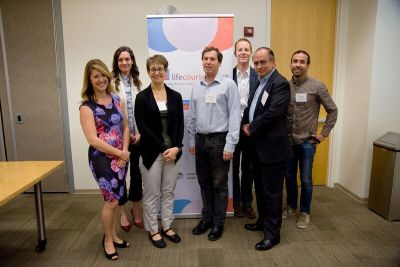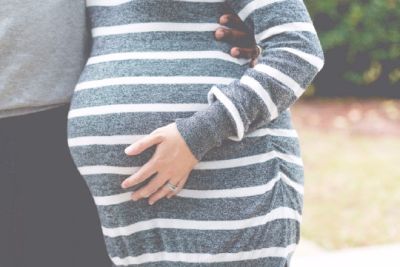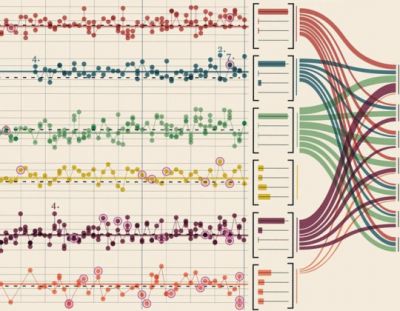Perinatal smoking in communities across Los Angeles County: Recent progress and why it matters
Our latest examination of L.A. County birth records highlights good news: The vast majority of women in L.A. County reported not smoking during pregnancy or in the three months before conception from 2007-2012. And perinatal non-smoking rates improved slightly during this period. Full results, plus interactive maps, can be found here.
Other key findings:
- All areas of the county saw improvements in perinatal non-smoking, though rates differed by region. While the Antelope Valley had the lowest percentage of births without perinatal smoking during 2007-2012, that region also experienced the greatest gains, e.g., figures in Service Planning Area (SPA) 1 rose from 95.5% to 96.5%.
- Among racial/ethnic groups countywide, perinatal non-smoking levels were lowest for Japanese, African American, and white mothers, though these three groups showed the largest improvements as well. Only one demographic group had greater gains during this period—those without fathers established on birth records. Specifically, perinatal non-smoking levels for births without paternity established increased from 95.1% to 97.2%.
- Improvement in perinatal non-smoking rates suggest that public health efforts to reduce smoking among expectant mothers—where smoking could have two-generation consequences—seem to be working.
Why does it matter?
Perinatal smoking not only harms the mother’s health but also increases the risk of infant death, premature birth, low birthweight, and birth defects, among other complications. Though these increases – in percentage terms – are relatively small, they represent thousands of infants and significant progress for maternal and child health in L.A. County.
Rose Hills Summer Research Fellowship
The Rose Hills Foundation, which supports non-profit organizations that serve the citizens of Southern California, generously provides funding for select students pursuing full-time research in science or engineering.
Chelsea Lee, one of our talented undergraduate research assistants, was awarded a Rose Hills Fellowship that will support her full-time position with the CDN this summer.
Congratulations, Chelsea! We’re excited to have you as part of our team, and thankful to the Rose Hills Foundation for their philanthropy.
CDN Event: International Workshop on Government Administrative Data for Policy-Relevant Research
The Children’s Data Network (CDN) at USC’s Suzanne Dworak-Peck School of Social Work was excited to co-host an international administrative data conference at Stanford University on May 1st and 2nd, 2017 with the Australian Research Council Centre of Excellence for Children and Families over the Life Course, the Program for Administrative Data at Stanford, and the Stanford Center for Poverty and Inequality.
The workshop was addressed to researchers with experience or interest in using government administrative data for research purposes. The key objectives of the workshop were to:
- Increase awareness on the opportunities, bounds, innovations and future directions of using government administrative data to solve policy-relevant questions across countries;
- Identify competences and capacity required to enable government administrative data to be used more widely and effectively;
- Identify strategies concerning communication and partnerships with government agencies, and sharing experience on how to address them.
Thanks to the support from USC’s Research Council, the entire CDN team was able to attend this convening. Not only did it facilitate team-bonding, it also allowed fostered connections with other researchers similarly engaged in analyses based on linked records, and provided a forum to discuss personal experiences with administrative data, brainstorm around challenges, and cement new interinstitutional relationships.
How is receipt of timely prenatal care changing across Los Angeles County, and why does it matter?
A new examination of L.A. County birth records highlights declines in receipt of timely prenatal care, but trends vary in different parts of the county. Full results, plus interactive maps, can be found here.
Among the key findings:
- The percentage of births to women receiving prenatal care in their first trimester declined between 2002 and 2012 (most recent decade of birth records available), countywide and in all regions except the San Fernando Valley.
- Receipt of timely prenatal care declined for nearly every demographic group in nearly every region of L.A. County during this decade—and inequities persisted, with receipt remaining less common among births to teens, women of color (particularly African Americans), mothers with lower education levels, and mothers with public insurance, as well as births where paternity was not established.
Why does it matter?
Quality health care in the first trimester of pregnancy lowers the risk of complications including low birth weight and premature birth, a leading cause of infant death. Research shows that a healthy birth—followed by safe, nurturing relationships and environments—sets children on a path toward good health into adulthood.
The policy and program landscape has changed dramatically since 2012, with a new federal health care system and many promising community programs launched or expanded in the last five years. As subsequent years of data become available, the impact of these changes may be reflected in the data, revealing improvements in access to prenatal care.
Given the uncertain future of health care programs at the federal level, it is important to ensure that recent improvements are maintained and that services to support healthy births continue to be a priority.
About the project
This is the second of four snapshots to be released in 2017, drawing on data from birth records to examine trends and regional differences within L.A. County. The first snapshot provided an overview of birth trends and family demographics as a foundation for the next three snapshots, which will explore specific indicators of healthy birth outcomes. This snapshot focuses on access to early prenatal care, and the next one will address perinatal smoking.
How are birth trends and family demographics changing across Los Angeles County, and why does it matter?
A new examination of L.A. County birth records reveals major demographic shifts, but trends vary in different parts of the county. Full results, plus interactive maps, can be found here: http://www.datanetwork.org/cdn-apps/birth-trends-and-family-demographics/
Among the key findings:
- The fertility rate—births per 1,000 women ages 15-49—declined significantly in all areas of the county from 2002 to 2012, the most recent decade of data available from birth records. The number of births dropped in all regions of the county, too, except in Antelope Valley which had a small increase (6%).
- The majority of births occurred in the San Gabriel and San Fernando Valleys, and the South L.A. region, during this decade.
- Births to teens dropped countywide, as well, with the greatest reductions in the San Fernando Valley, West L.A. areas, and South Bay.
- During 2002-2012, all areas of the county also saw declines in births to women who had not completed high school. Trends varied, though, for infants whose mothers had college degrees, with decreases in the Metro, South, and East L.A. areas, and in Antelope Valley, but substantial increases in the West L.A. areas.
- The number of births to white and Latina mothers dropped countywide by 33% and 19%, respectively, during this decade, whereas births to Chinese mothers rose 146%—this increase was most dramatic in the San Gabriel Valley.
- The report also includes 2006-2016 data on the 400,000+ low-income women and young children served by the Special Supplemental Nutrition Program for Women, Infants, and Children (WIC) in L.A. County. These data reveal decreasing percentages of participants with Spanish as their preferred language, and rising percentages who prefer English, in every region of the county.
Why does it matter? L.A. County’s shrinking child population, retiring baby boom generation, and projected workforce shortages indicate that children are an increasingly vital resource for the county’s future prosperity. Supporting families with young children, in particular, is essential for a thriving future population, as the building blocks for lifelong health and wellness are set in the earliest years of childhood. Decades of research show investments in young children pay off.
Understanding demographic trends by region is critical for planning services to meet changing needs and for making effective investments in systems to support children and families. Historic service distribution patterns may need to change to meet shifting demographic conditions, and communities with the largest concentrations of young children need the infrastructure and resources to support these families. Assuring a healthy start for children should be one of the highest priorities for our county—our future literally depends on it.
About the project
This is the first of four Children’s Data Network “Connecting the Dots” snapshots to be released in 2017, drawing on data from birth records to examine regional trends within L.A. County. The next three snapshots will explore specific indicators of healthy birth outcomes. The Connecting the Dots project brings together data and stories to provide new insights about the health and well-being of children and families in L.A. County.
CDN’s Dr. Jacquelyn McCroskey Appointed to Assembly Speaker’s Blue Ribbon Commission on Early Childhood Education
Recently, Assembly Speaker Anthony Rendon (D-Paramount) launched the Speaker’s Blue Ribbon Commission on Early Childhood Education, a policy-driven body tasked with identifying ways to create a more sustainable early learning system and update an outdated funding plan that has been unable to meet the demand for child care access in California. The commission will enable the Assembly to find ways to improve the state’s early learning system, and realize those improvements through policy and budget decisions.
Our very own Dr. Jacquelyn McCroskey, John Milner Professor of Child Welfare and Co-Director of the Children’s Data Network at the University of Southern California’s Suzanne Dworak-Peck School of Social Work, has been appointed to serve on the commission. She will collaborate alongside multiple Assemblymembers and eight other community members to develop solutions to improve results for California’s youngest learners and their families.
Congratulations Jacquelyn!
For more information, please click here.
CCRC/CDN Study Presented at Early Childhood Education / Child Welfare Summit
In January, Dr. Susan Savage of the Child Care Resource Center and Dr. Jacquelyn McCroskey of the Children’s Data Network were invited to present at the inaugural session of an ECE-child welfare summit designed to improve cross-system understanding and connections. Led by Senator Holly Mitchell and others, this was an effort to bring leaders of the two systems together in order to facilitate understanding and foster collaboration. To that end, CDN and CCRC prepared three documents. The first summarizes our findings of the overlap of children in child care and child protection systems in LA County (Linking Data to Inform Policy for Vulnerable Children), the second discusses how accessing data across systems can facilitate service delivery and provision of appropriate supports (Accessing Data Across Systems is Critical), and the third speaks to the importance of interagency collaboration in that process (Developing Inter-agency Collaboration).
Photo courtesy of First 5 LA
Do Good with Data: We’re Hiring!
Do you love tasks related to data management? Statistical analyses? Leveraging those skills to inform programs and policies for young children and their families? Then we welcome you to apply to be our new full-time Research Programmer. We are looking for someone who can assume responsibility for a range of tasks related to data management and statistical analyses.
This person will:
- Work closely with our database analyst, senior statistician, IT staff, public agency partners, doctoral students, and PhD-level researchers to manage administrative records and conduct applied analyses.
- Support the development of the CDN’s linked administrative database by assuming responsibility for SQL tasks, including the preparation of raw data extracts received from agency partners for record linkage (e.g., coding, cleaning, standardizing).
- Support the preparation of analytic files for researchers at the CDN, including harmonizing variables across years, developing coding protocols for derived fields, supporting meta-data documentation, and running descriptive statistics and multivariable models.
- Contribute to the development of data and research products (e.g., metadata, technical reports, empirical papers).
They will be expected to have the following technical skills:
- Master’s degree in biostatistics, computer science, or related field.
- Advanced skills in programming and experience in database management.
- Sufficiently detailed understanding of statistical software (Stata/SAS/R) to effectively collaborate with the CDN research team.
Candidates should enjoy working both independently and collaboratively in an academic environment, possess excellent organizational skills and the ability to balance multiple tasks, and have an interest in applied and policy-focused research.








